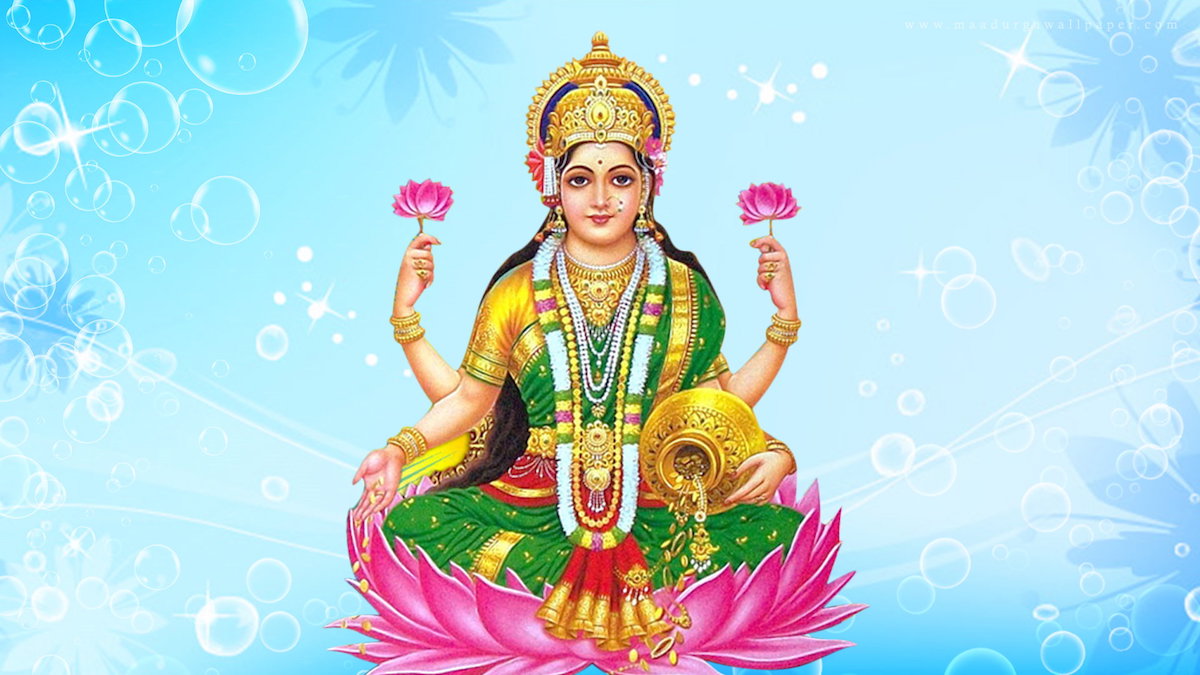Having begun the New Year under the care of Ganesha, we are now in a good place to consider who else in the realm of Hinduist gods might accompany us on our journey this year. Quite likely when we start something new, we wish that whatever project we are devoting our time, energy, and other resources to will grow and foster. Lakshmi, the goddess of wealth, fortune, and prosperity is said to aid in bringing about a prosperous outcome of our undertakings.
Lakshmi has the symbolic meaning of knowing and understanding your goals, as the Sanksrit root of the word is lakṣa(लक्ष), meaning to perceive, observe, know, understand, but also goal, aim, objective. Another related term is lakṣaṇa, meaning sign, target, aim, symbol, attribute, quality, lucky mark, auspicious opportunity. The name’s symbolism as well as the statues’ symbolic representation of wealth and prosperity is by no means restricted to the material world. This goddess is much more a representation of spiritual wealth, of self-realization and knowledge.
In fact, in a lot of artwork Lakshmi is depicted as having for arms, which represent the four goals of humanity according to Hinduism: dharma – pursuit of an ethical, moral life, artha – pursuit of wealth, means of life, kama – pursuit of love, emotional fulfillment, and moksha -pursuit of self-knowledge, liberation. Thus, we see that Lakshmi’s qualities do not only manifest in the material world. The prosperity and wealth she embodies is to be experienced in all parts of human existence to give it weight and depth. Also, always present is the lotus flower, in which Lakshmi stands or sits. The lotus symbolizes knowledge, self-realization and liberation and since it is a flower that blossoms in clean or dirty water it also represents purity and beauty regardless of the good or bad circumstances in which its grows.
Legend has it that Lakshmi was born out of the Ocean of Milk as a result of the Devas (gods) and Asuras (demons) quest for immortality. The Ocean of Milk, Kshirasaga, containing the nectar Amrita, which grants immortality, had to be stirred to release its wonderful potion. So the gods and demons got together, took Mount Mandhara, put it on top of a tortoise (Kurma), wrapped the serpent-god around it and started churning. In this process, Lakshmi suddenly emerged out of the sea. As the element water also represents fertility, it is related to the second chakra (the sacral chakra), which relates to relationships, sexuality and creativity. So, again we see that Lakshmi has a much deeper meaning than material wealth, as other symbolic representations of her show.
From her open hands she pours wealth – material as well as spiritual wealth – which is a mudra (gesture) that signifies compassion, giving or daana (charity). This reminds us that whatever we are given we are meant to share with others, not just simply hoard for ourselves. Through our Yoga practice we might gain greater self-awareness and a deeper understanding, which when used rightly, will benefit those around us because we might begin to extend the same compassion and kindness to others, that we learn to give to ourselves. We might also find in our practice that through doing our dharma – our innate purpose for being in this life – we are here to serve others; in whatever way shape or form. We might begin to see that prosperity and wealth is really a state of mind and an inner experience, rather than an external condition. We might see that whatever we share with others multiplies tenfold and that it is through giving that we receive.
May you have a prosperous month of February and may you share your joy, beauty, and love with others!
Namaste.
by Carina Hilmar

